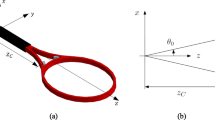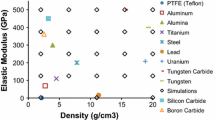Abstract
Rubber is a material present in many commodities, including tennis balls. The characteristics of tennis balls are specified by the International Tennis Federation and are evaluated using standard tests that are too cumbersome to be staged easily and quickly. In this article we present an experimental method based on the propagation of highly nonlinear solitary waves (HNSWs) to determine the internal pressure of tennis balls and to estimate rubber degradation. HNSWs are compact waves that can form and travel in a closely-packed assembly of systematically arranged particles that generally interact according to the Hertz contact law. In the study presented here, we developed a model that predicts the internal pressure of tennis balls and estimates rubber degradation by observing the waves propagating within a chain in contact with the ball to be estimated. The model was validated experimentally, by testing 18 identical balls played over a few weeks period. We found that the dynamic interaction between the waves and the rubber can successfully detect changes in internal pressure and bouncing characteristics and that these changes were barely detected using a conventional rebound test. In the future, the findings of this study may be expanded to characterize any rubber of any shape.










Similar content being viewed by others
References
(ITF) ITF International Tennis Fedration (ITF) (2018) http://www.itftennis.com/technical/balls/approval-tests.aspx Accessed Feb 2018
Technical I. http://www.itftennis.com/technical/. Accessed 2 March 2018
Steele C (2006) Tennis ball degradation. © Carolyn Steele
International Tennis Fedration (ITF). http://www.itftennis.com/media/278130/278130.pdf
Cross R (1999) Dynamic properties of tennis balls. Sports Eng 2:23–34
Haron A, Ismail K (2012) Coefficient of restitution of sports balls: a normal drop test. In: IOP conference series: materials science and engineering. vol 1. IOP Publishing, p 012038
Bridge NJ (1998) The way balls bounce. Phys Educ 33(3):174
Hubbard M, Stronge W (2001) Bounce of hollow balls on flat surfaces. Sports Eng 4(2):49–61
Andersen T (1999) Collisions in soccer kicking. Sports Eng 2(2):121–125
Haake S, Carre M, Goodwill S (2003) The dynamic impact characteristics of tennis balls with tennis rackets. J Sports Sci 21(10):839–850
Goodwill S, Haake S (2004) Modelling of tennis ball impacts on a rigid surface. Proc Inst Mech Eng C J Mech Eng Sci 218(10):1139–1153
Nagurka M, Huang SA (2004) Mass-spring-damper model of a bouncing ball. In: American Control Conference, 2004. Proceedings of the 2004. IEEE, pp 499–504
Wadhwa A (2009) Measuring the coefficient of restitution using a digital oscilloscope. Phys Educ 44(5):517
Wadhwa A (2012) Measuring the rebound resilience of a bouncing ball. Phys Educ 47(5):620
Wadhwa A (2013) Study of the dynamic properties and effects of temperature using a spring model for the bouncing ball. Eur J Phys 34(3):703
Bagheri A, Rizzo P (2017) Assessing the pressure of tennis balls using nonlinear solitary waves: a numerical study. Sports Eng 20(1):53–62
Nasrollahi A, Rizzo P, Orak MS (2018) Numerical and experimental study on the dynamic interaction between highly nonlinear solitary waves and pressurized balls. J Appl Mech 85(3):031007–031011. https://doi.org/10.1115/1.4038990
Nasrollahi A, Orak MS, Kosinski K, James A, Weighardt L, Rizzo P (2018) An alternative noninvasive approach to characterize tennis balls. J Nondestr Eval Diagn Progn Eng Syst (in press)
Yang J, Silvestro C, Khatri D, De Nardo L, Daraio C (2011) Interaction of highly nonlinear solitary waves with linear elastic media. Phys Rev E 83(4):046606
Bagheri A, La Malfa Ribolla E, Rizzo P, Al-Nazer L, Giambanco G (2015) On the use of l-shaped granular chains for the assessment of thermal stress in slender structures. Exp Mech 55(3):543–558
Nesterenko V (1983) Propagation of nonlinear compression pulses in granular media. J Appl Mech Tech Phys 24(5):733–743
Nesterenko V, Lazaridi A, Sibiryakov E (1995) The decay of soliton at the contact of two “acoustic vacuums”. J Appl Mech Tech Phys 36(2):166–168
Nesterenko VF (2013) Dynamics of heterogeneous materials. Springer Science & Business Media, New York
Lazaridi A, Nesterenko V (1985) Observation of a new type of solitary waves in a one-dimensional granular medium. J Appl Mech Tech Phys 26(3):405–408
Coste C, Falcon E, Fauve S (1997) Solitary waves in a chain of beads under hertz contact. Phys Rev E 56(5):6104
Daraio C, Nesterenko V, Herbold E, Jin S (2005) Strongly nonlinear waves in a chain of Teflon beads. Phys Rev E 72(1):016603
Daraio C, Nesterenko V, Herbold E, Jin S (2006) Tunability of solitary wave properties in one-dimensional strongly nonlinear phononic crystals. Phys Rev E 73(2):026610
Job S, Melo F, Sokolow A, Sen S (2005) How Hertzian solitary waves interact with boundaries in a 1D granular medium. Phys Rev Lett 94(17):178002
Job S, Melo F, Sokolow A, Sen S (2007) Solitary wave trains in granular chains: experiments, theory and simulations. Granul Matter 10(1):13–20
Carretero-González R, Khatri D, Porter MA, Kevrekidis P, Daraio C (2009) Dissipative solitary waves in granular crystals. Phys Rev Lett 102(2):024102
Yang J, Daraio C (2013) Frequency-and amplitude-dependent transmission of stress waves in curved one-dimensional granular crystals composed of diatomic particles. Exp Mech 53(3):469–483
Yang J, Gonzalez M, Kim E, Agbasi C, Sutton M (2014) Attenuation of solitary waves and localization of breathers in 1D granular crystals visualized via high speed photography. Exp Mech 54(6):1043–1057
Li K, Rizzo P (2015) Energy harvesting using arrays of granular chains and solid rods. J Appl Phys 117(21):215101
Li K, Rizzo P (2015) Energy harvesting using an array of granules. J Vib Acoust 137(4):041002
Li K, Rizzo P, Bagheri A (2015) A parametric study on the optimization of a metamaterial-based energy harvester. Smart Mater Struct 24(11):115019
Li K, Rizzo P (2017) Experimental parametric analysis of an energy harvester based on highly nonlinear solitary waves. J Intell Mater Syst Struct 28(6):772–781
Daraio C, Nesterenko V, Herbold E, Jin S (2006) Energy trapping and shock disintegration in a composite granular medium. Phys Rev Lett 96(5):058002
Deng W, Nasrollahi A, Rizzo P, Li K (2016) On the reliability of a solitary wave based transducer to determine the characteristics of some materials. Sensors 16:5. https://doi.org/10.3390/s16010005
Nasrollahi A, Deng W, Rizzo P, Vuotto A, Vandenbossche JM (2017) Nondestructive testing of concrete using highly nonlinear solitary waves. Nondestr Testing Eval 32(4):381–399. https://doi.org/10.1080/10589759.2016.1254212
Rizzo P, Nasrollahi A, Deng W, Vandenbossche J (2016) Detecting the presence of high water-to-cement ratio in concrete surfaces using highly nonlinear solitary waves. Appl Sci 6(4):104
Schiffer A, Alkhaja A, Yang J, Esfahani E, Kim T-Y (2017) Interaction of highly nonlinear solitary waves with elastic solids containing a spherical void. Int J Solids Struct
Ni X, Rizzo P (2012) Highly nonlinear solitary waves for the inspection of adhesive joints. Exp Mech 52(9):1493–1501
Singhal T, Kim E, Kim T-Y, Yang J (2017) Weak bond detection in composites using highly nonlinear solitary waves. Smart Mater Struct 26(5):055011
Schiffer A, Lee D, Kim E, Kim TY (2018) Interaction of highly nonlinear solitary waves with rigid polyurethane foams. Int J Solids Struct. https://doi.org/10.1016/j.ijsolstr.2018.05.010
Yang J, Sangiorgio SN, Borkowski SL, Silvestro C, De Nardo L, Daraio C, Ebramzadeh E (2012) Site-specific quantification of bone quality using highly nonlinear solitary waves. J Biomech Eng 134(10):101001
Bathe K-J (2006) Finite element procedures. Prentice Hall, Pearson Education, Inc. K-J Bathe, London
Belytschko T, Liu WK, Moran B, Elkhodary K (2013) Nonlinear finite elements for continua and structures. Wiley, West Sussex
Goodwill S, Kirk R, Haake S (2005) Experimental and finite element analysis of a tennis ball impact on a rigid surface. Sports Eng 8(3):145–158
Frey PJ, George PL (2000) Mesh generation: application to finite elements. Hermes Science Europe, Oxford
Goodwill S, Haake S (2004) Ball spin generation for oblique impacts with a tennis racket. Exp Mech 44(2):195–206
Cross R (2014) Oblique bounce of a rubber ball. Exp Mech 54(9):1523–1536
Herbold EB (2008) Optimization of the dynamic behavior of strongly nonlinear heterogeneous materials. University of California, San Diego
Sissler L (2012) Advanced modelling and design of a tennis ball. © Lise Sissler, Loughborough
Sissler L, Jones R, Leaney P, Harland A (2010) Viscoelastic modelling of tennis ball properties. In: IOP conference series: materials science and engineering. vol 1. IOP Publishing, p 012114
Acknowledgments
This project was supported by the University of Pittsburgh CRDF seed funding. The second author conducted this research as part of a Pittsburgh Allderdice High School research class, where high school students work on projects much like the undergraduate research experience. The mentoring effort of Dr. Janet R. Waldeck, National Board Certified Teacher, is very much appreciated. Finally, we thank Drs. Vidic and Fazzari for using the test samples and providing fruitful comments and suggestions about the serviceability of tennis balls.
Author information
Authors and Affiliations
Corresponding author
Rights and permissions
About this article
Cite this article
Nasrollahi, A., Lucht, R. & Rizzo, P. Solitary Waves to Assess the Internal Pressure and the Rubber Degradation of Tennis Balls. Exp Mech 59, 65–77 (2019). https://doi.org/10.1007/s11340-018-0432-1
Received:
Accepted:
Published:
Issue Date:
DOI: https://doi.org/10.1007/s11340-018-0432-1




